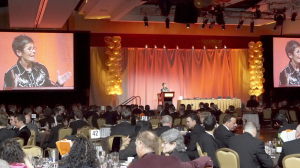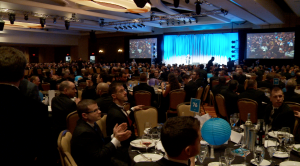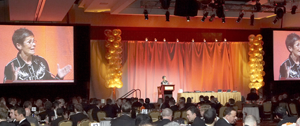 The mission of any non-profit organization, large and small, is to help a cause, spread a message, and change the world. Change, however, has a price tag. There are innumerable ways to reach out to donors. One way, used quite often, is to host a dinner party or gala event that both brings like-minded people together for a fun evening, but also restates the mission of the non-profit, the benefits of giving, and the goals for the future. To fill out the events of the evening, there are likely speeches and awards given by and for top benefactors and there may even be some musical entertainment, but while you’re in a hotel ballroom or local function hall, it’s difficult to show the audience the non-profit at work in the field, helping others or providing needed services. That’s where video can play a huge role.
The mission of any non-profit organization, large and small, is to help a cause, spread a message, and change the world. Change, however, has a price tag. There are innumerable ways to reach out to donors. One way, used quite often, is to host a dinner party or gala event that both brings like-minded people together for a fun evening, but also restates the mission of the non-profit, the benefits of giving, and the goals for the future. To fill out the events of the evening, there are likely speeches and awards given by and for top benefactors and there may even be some musical entertainment, but while you’re in a hotel ballroom or local function hall, it’s difficult to show the audience the non-profit at work in the field, helping others or providing needed services. That’s where video can play a huge role.
 A video can show and tell your non-profit’s mission and involvement better than any speech or slide show and actually transport your audience to places they might not be able to see. Video, when produced correctly, pulls at the purse strings and can create a mood in the room or elicit a variety of emotions. Animation can be used to chart out the successes and goals of your non-profit. There’s no substitute for such a multi-faceted medium, but only when it’s done right.
A video can show and tell your non-profit’s mission and involvement better than any speech or slide show and actually transport your audience to places they might not be able to see. Video, when produced correctly, pulls at the purse strings and can create a mood in the room or elicit a variety of emotions. Animation can be used to chart out the successes and goals of your non-profit. There’s no substitute for such a multi-faceted medium, but only when it’s done right.
There are many stories you could tell about how your non-profit has helped the community, but that can lead to a trap that even the largest non-profits fall into: An unbearably long video. A successful video is succinct and to the point. Having a video that is shorter and composed of high quality content is infinitely more powerful than one that gives example after example and bores the audience. The absolute LAST thing you want to do is to disengage your audience. It’s really hard sometimes to decide what to keep and lose. One trick is to view the video from the perspective of someone who doesn’t know anything about your non-profit. You can either bring in a third party or use your imagination, but it’s extremely helpful as certain interviews or facts in the video will start to stick out as extraneous, repetitive, or unnecessary. At the same time, you don’t want the video so lean that it loses the message or emotional impact. A great target length for your video would be around 2 to 3 minutes where you spend maybe a minute describing your mission, a minute describing how your non-profit helps, and then a conclusion that describes the goals for the future and why someone should donate money to your cause. Of course there are many different styles and structures to videos, but this structure is typical and highly successful.
 With the structure of the video in mind, it’s important to have the right people talking in your video. Any interview-based video should show a diversity of people to help convey how many people work at, volunteer, or are helped by your organization. Also important is who is saying what information. If your organization assists people with a medical condition, then it’s likely that you will want a doctor to describe the advancements in research and how it helps his/her practice, but the symptoms of the condition should be described by someone who has the disease and struggles with it, someone with whom your audience can relate to. In the same vein, you definitely want a leader in your organization to describe the goals for the future because it might not make sense coming from a regular person who has little decision-making power in the non-profit. You also want to interview people who present themselves well on camera. For instance, sometimes the head chairperson of a non-profit is a great leader but not well spoken. You might consider a second in command who has great charisma. Whoever you choose to interview for your video, never forget who your audience is and how they will perceive that person in the context of the video.
With the structure of the video in mind, it’s important to have the right people talking in your video. Any interview-based video should show a diversity of people to help convey how many people work at, volunteer, or are helped by your organization. Also important is who is saying what information. If your organization assists people with a medical condition, then it’s likely that you will want a doctor to describe the advancements in research and how it helps his/her practice, but the symptoms of the condition should be described by someone who has the disease and struggles with it, someone with whom your audience can relate to. In the same vein, you definitely want a leader in your organization to describe the goals for the future because it might not make sense coming from a regular person who has little decision-making power in the non-profit. You also want to interview people who present themselves well on camera. For instance, sometimes the head chairperson of a non-profit is a great leader but not well spoken. You might consider a second in command who has great charisma. Whoever you choose to interview for your video, never forget who your audience is and how they will perceive that person in the context of the video.
There are many ways to show the ways your non-profit helps the world, but nothing more powerful than a personal success story or testimonial. This isn’t just an interview, but also supporting footage that shows the person using the services, treatment, or other help that your organization provides. Mixing that ‘b roll’ footage with the interviews will drive home points to your audience by both showing and telling.
It’s also a rule in movies, television, and other visual media that it’s of much more importance to show than tell. If you can think of the best, most memorable scene in a movie, it’s likely a point when perhaps nothing was said. Rather, there was a car chase, explosion, a facial expression, landscape, or other visual element. This technique was used in this infamous political ad by Lyndon B. Johnson’s presidential campaign against challenger Barry Goldwater.
This is where style and creativity can play into your video. Perhaps seeing animals being tortured or the faces of hungry children is enough by itself to spur action than having someone telling you that these things are terrible. Perhaps your non-profit needs no verbal explanation at all.
There are many, many ways to execute your video and as long as it gets your audience to donate to your cause, it can be deemed a success, but remember that more often than not, a video that can truly melt a heart and change the world.
Here are some examples of videos McElroy Films produced for gala events including Fenway Health, Habitat for Humanity, and Mattapan Community Health Center:

